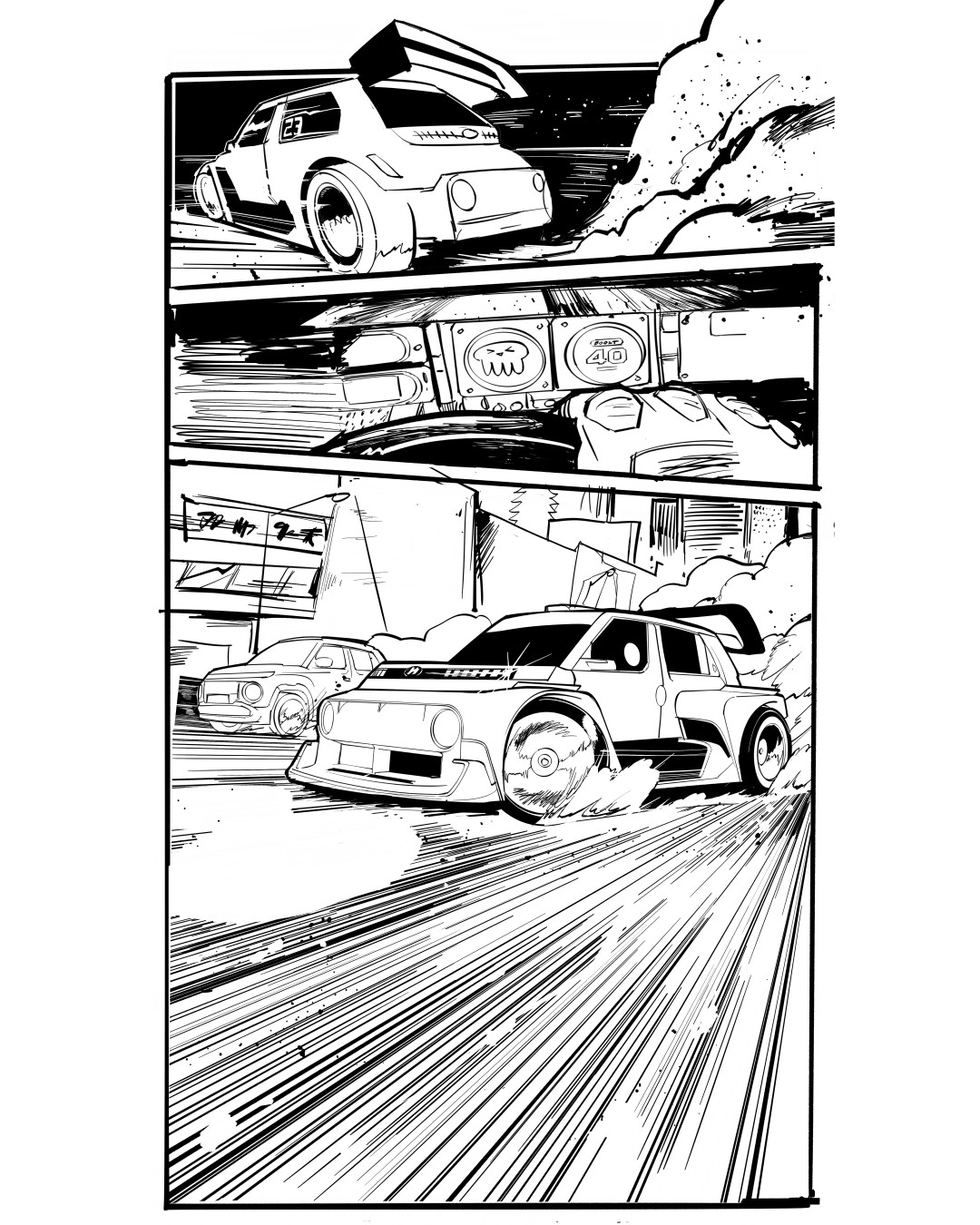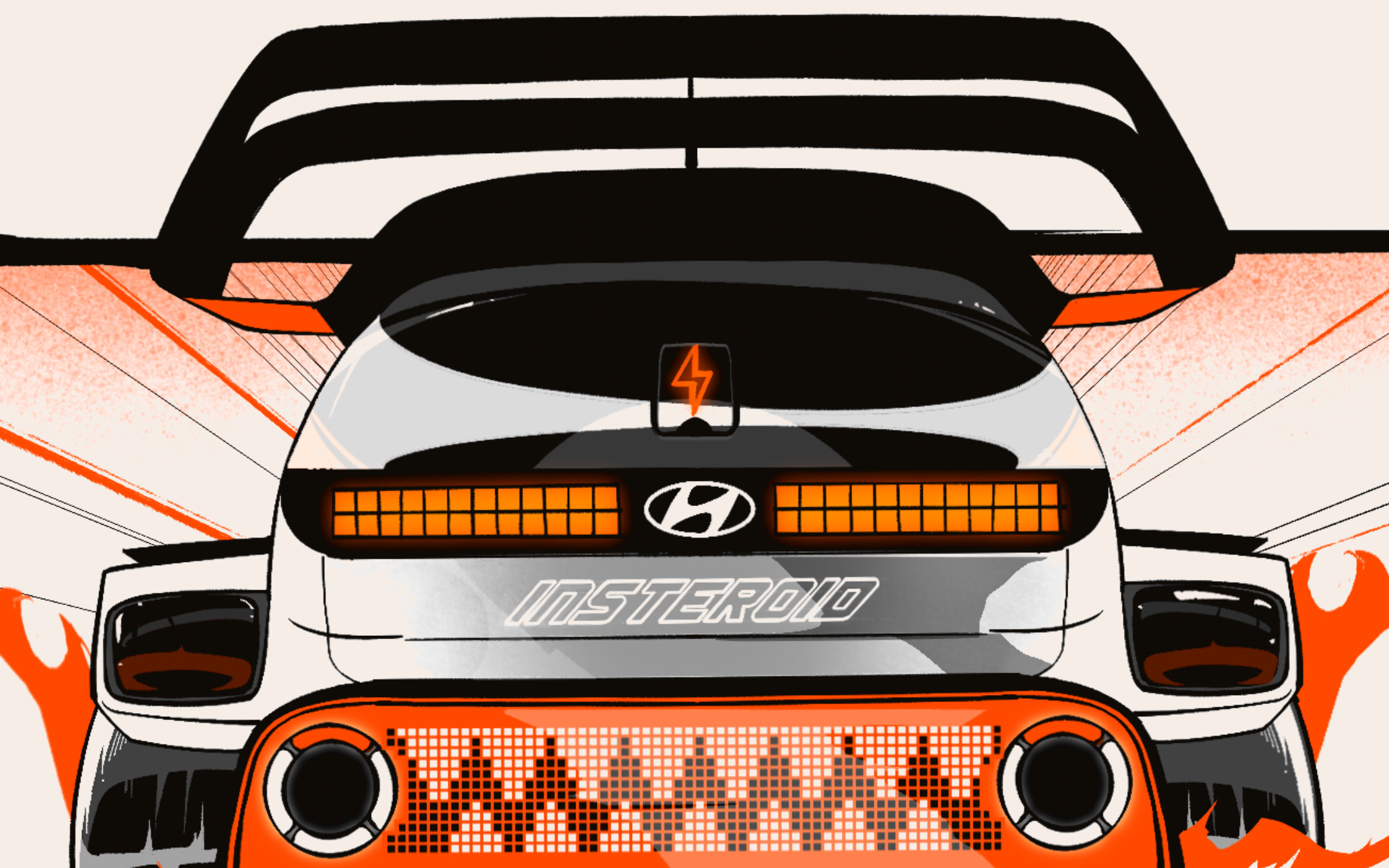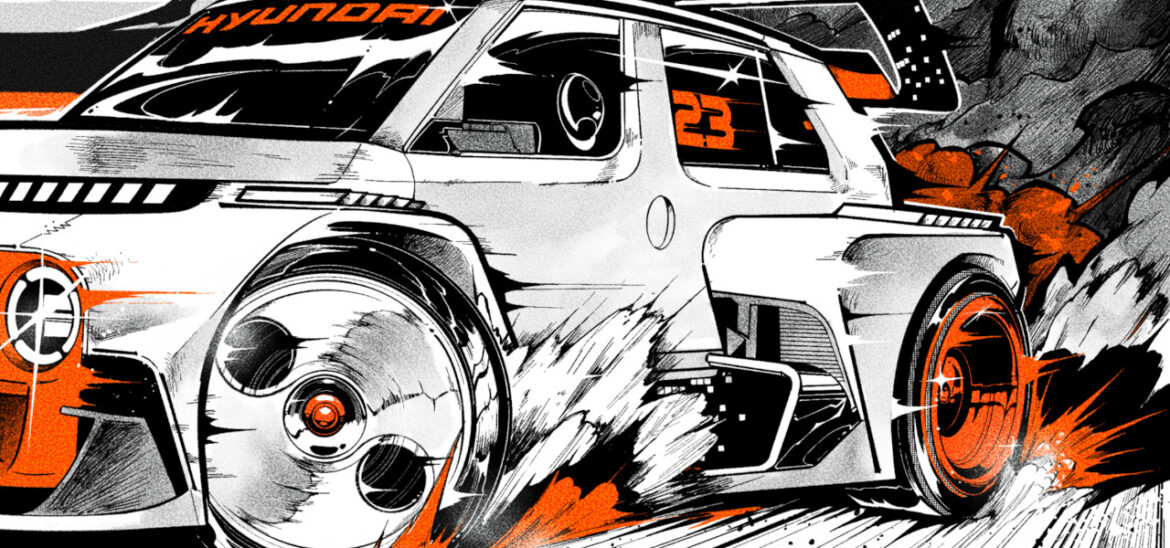Like a living splash panel from a manga comic, the animated advertisement for Hyundai Insteroid X JDM: Japanese Drift Master shows a custom street rod sliding around a curve with smoke streaming from its wheels. In orange and black duotones, with graphic scrolling dials, slash frames of a chomping rear digital display, and a racetrack snaking past a Japanese pagoda, the 12-second loop heralds the arrival of the Hyundai Insteroid concept car in Gaming Factory’s popular single-player open-world racing game.
The animation, produced in collaboration with Hyundai and Innocean Worldwide in Seoul, was the work of James Martin, a U.S.-born animator from Salt Lake City, Utah, working at Studio Cartoons Deluxe in Oslo, Norway.
Martin’s interest in animation sprang from his experiences as the nephew of animator Ron Hughart, recently retired supervising director of American Dad! and director of Futurama and Ren & Stimpy. Visits to Spümcø in the early 1990s inspired Martin to pursue animation via art school in Seattle, where he met his Finnish wife. This led him to agency work in Helsinki and then Norway.
After going freelance, a collaboration with the Bremont Watch Company resulted in an animated promo for the Atlassian Williams Racing Formula 1 team for the Silverstone Grand Prix. Martin’s portfolio of animation and graphics — Formula 1, hot rods, and fantasy creations — then caught Hyundai’s eye.
“I am a car guy,” said James Martin. “Hyundai found me via Instagram and wanted to do a collaboration. They used examples of my own work as reference, which is an encouraging way to begin a project.”
Martin met with Cartoon Brew via video link from Oslo to discuss his creative process and his passions for animation and fast cars.
Cartoon Brew: What was it about that first assignment with Bremont-Williams that led you to gravitate toward these stylized auto renderings?
James Martin: That was my first big international client. Because we don’t get stuff like that in Oslo — there are no F1 jobs or anything like that here, it’s all local — I poured myself into that job. And it was the foundation of all the work that I do now with cars. By creating a loop, it was just a static image, but at the same time, it was dynamic. I thought there was something to that. So I continued to do those jobs, even as personal work. And then, this year, that led to my work with Porsche Norway. That’s when I decided to focus on cars.
So the dynamic graphic of the car creates a feeling of motion?
Martin: Yes, exactly. You’re locked on this one view of the car at one angle, but by adding details, you can make it look like it’s going super fast. I find that fascinating. You can make an object feel like it’s going extremely fast, but it doesn’t have to be moving all around. It has one perspective. And I really like that.

In Japanese Drift Master, what is the featured foreground car?
Martin: It’s based on a commercial Hyundai car, the Inster. But it’s called the “Insteroid,” so it’s a play on the name, as a souped-up, just-go-nuts version. It is specific to the urban drift culture, and especially gaming interests. The interior of the car has all these displays that have a lot of amazing character animations. There’s a character associated with the car as well. And on the driver’s-side passenger window, the number “23” is a reference to how there are 23 hidden characters as Easter eggs within the car.
If somebody knows where to look in the clip, will they find those?
Martin: Not all 23, but there are a few.
What was the agency’s brief?
Martin: Initially, they couldn’t reveal the title of the game, but they could tell me the model of the car and the concept. And they wanted to hear my ideas to present to their client.
Did they give you models in 3D?
Martin: Yes, I had a 3D model for both cars. I’m not proficient in 3D, so I used Blender to find different angles, because it’s hard to rely on photo reference. For this, I had to find exactly the angle that I wanted to work with. I used the 3D models and positioned them together to get that drift angle and to show off the front and the side of the car as best as I could. I screenshot those and bring them into Procreate.

How did you create your pluming smoke and dynamic action-line effects?
Martin: I did all the animation in [Savage Interactive] Procreate on an iPad Pro. I work on a one-strip timeline. I make loops for every little piece. Those are comprised of a variety of different frame rates and numbers of frames. I then export those either as PSDs or PNG sequences. And then I use After Effects to composite.
Did the client give you music timings?
Martin: No, the music came up at the very end. They asked me if I could find a library cue. As it turned out, I have a hobby of making music. I use Ableton, and then I have a handful of different synths like an ARP Odyssey, among others. The music in that clip is one of my own pieces. I gave them a few options, and they chose that one.
Your rendering has a Roy Lichtenstein Pop Art feel—what inspired that?
Martin: That comes from my interest in 1970s “Bronze Era” comics. Usually, I first make a drawing in black, and color comes afterward. For this, I was quite familiar with that tone of orange because it’s the brand color of another car-related client of mine, Rennmeister. A lot of my work ends up being black and white, with one color or duotone.

What was your final output?
Martin: The agency gave me flexibility on length. To be on the safe side, I created this in 4K, and I picked a length that worked best so that I wouldn’t have any problems with frame rates. Everything was in 30 fps. Some loops I had on ones that were only two frames. Some were on threes, some were on fours, six, eight, ten [frames]. Some ran the full clip. I made sure to keep everything workable. Then there was a separate A2 poster.
Did you adapt the poster from the 9:16-format vertical animated clip?
Martin: When we started, we talked about creating two animations; it then became the potential to do the poster instead. That was a different graphic, using the same drawing of both cars and the road, with a new background. The poster will be released at the upcoming Tokyo Motor Show—or the Japanese Mobility Show, as it’s now called.

Where can our readers expect to see your animated clip?
Martin: It’s shared on both Hyundai’s and my Instagram profiles. It coincided with the Japan Mobility Show, where the poster was presented. Hyundai has been very good about working with artists and animators. I think they’ll be very happy they’re getting this kind of press.
The Japanese Mobility Show (MobiShow 2025) is running Oct. 30–Nov. 9 at the Big Sight exhibition center in Tokyo. JDM: Japanese Drift Master is available through Epic Games and Steam.


AloJapan.com